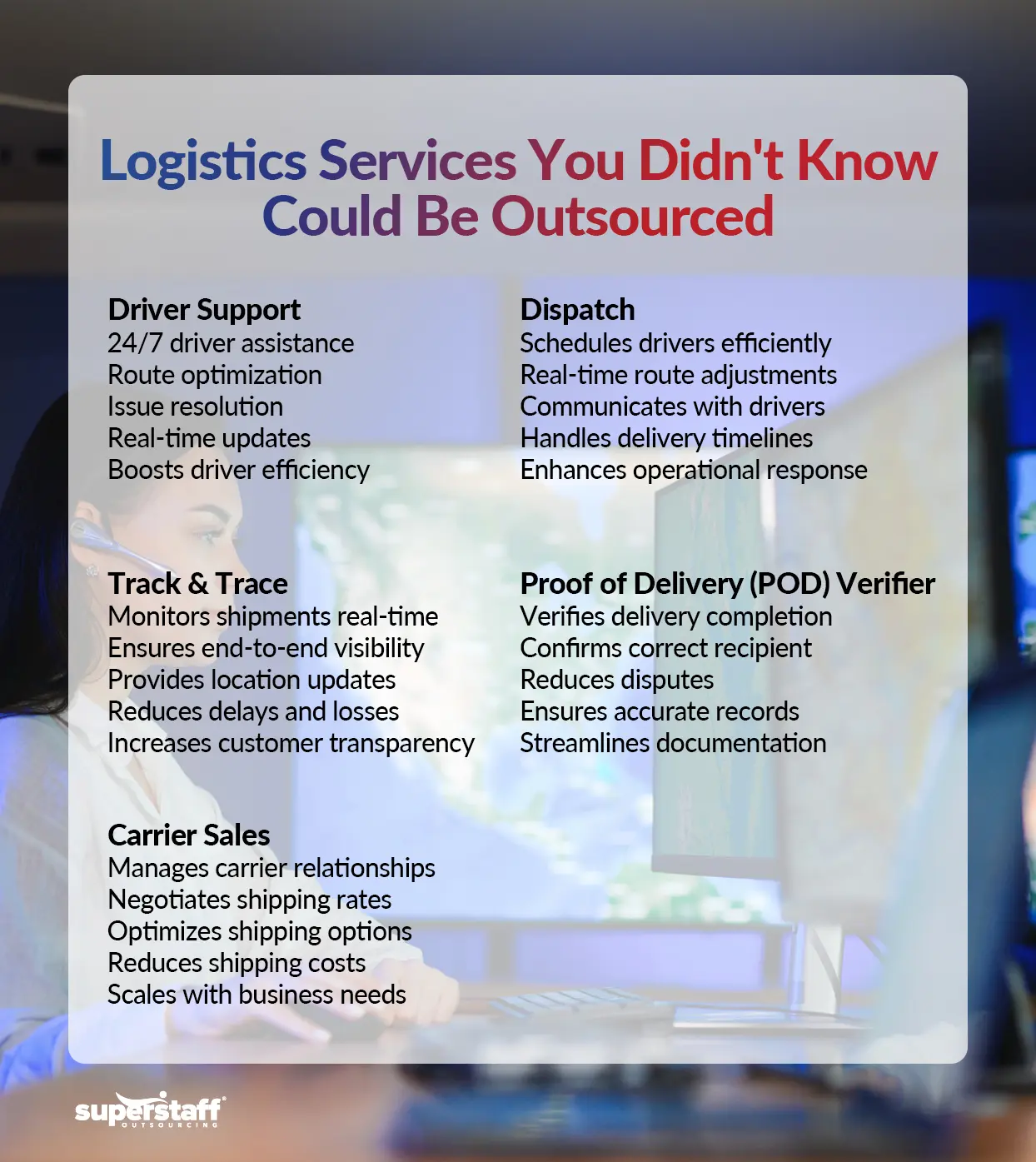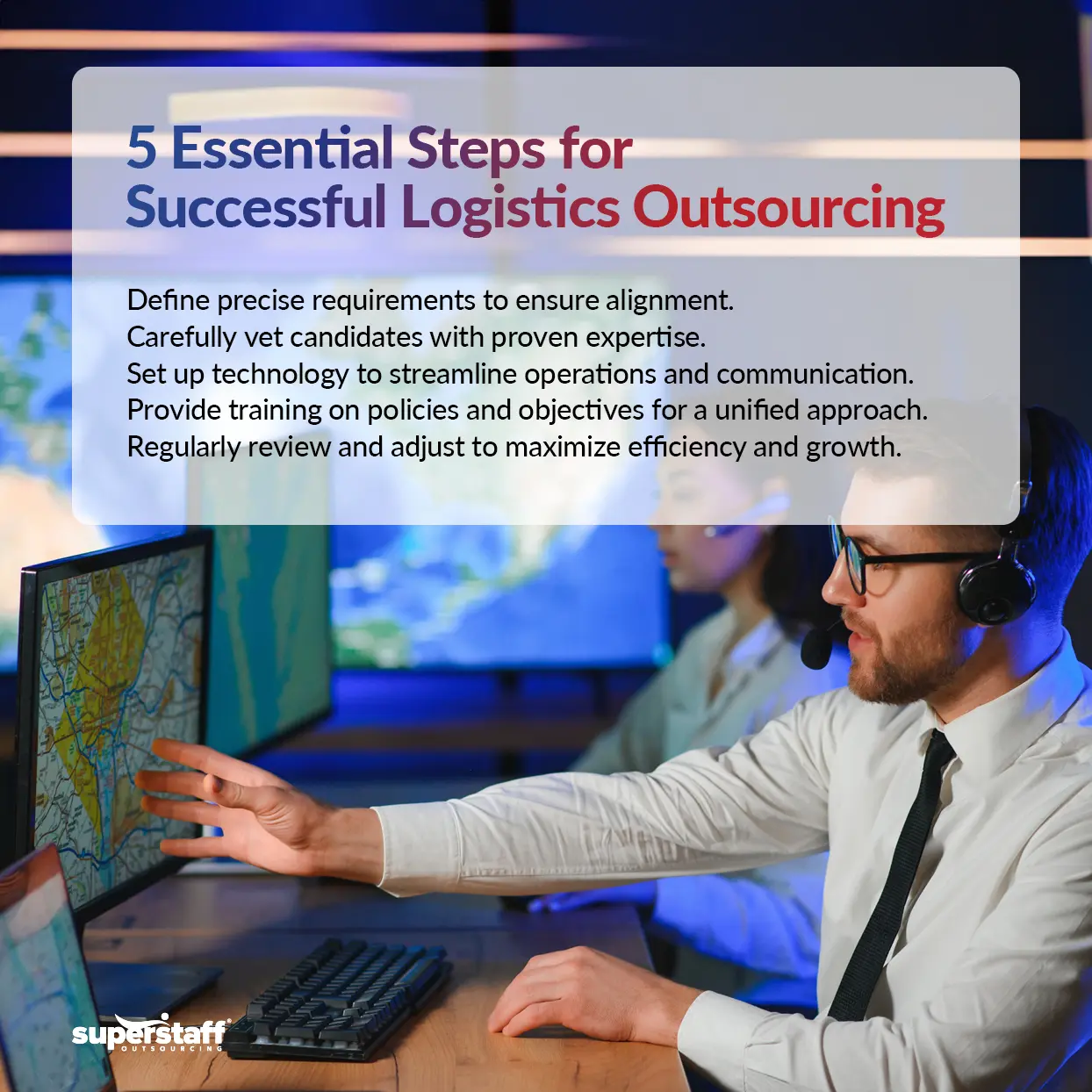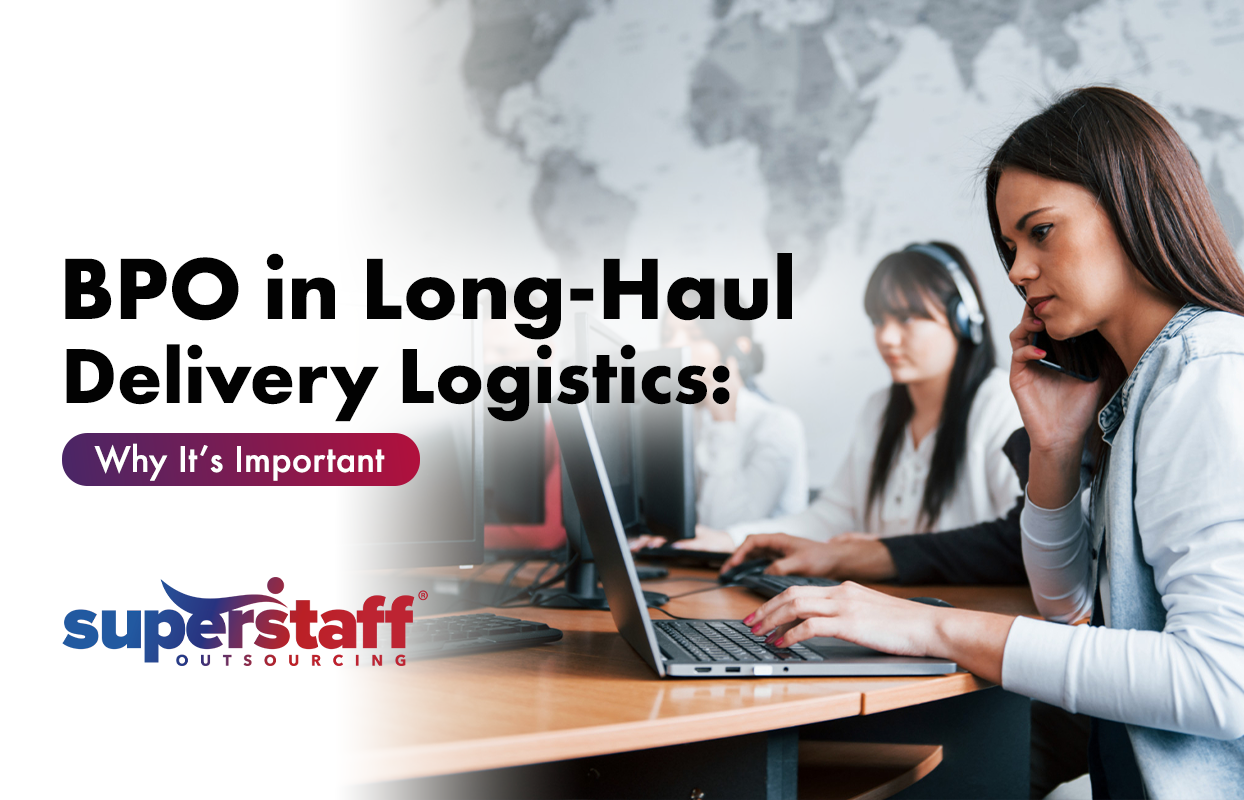
Managing logistics operations is no easy task. The complexities involved, from driver support to tracking deliveries, can consume significant time and resources. Yet, logistics shape your brand’s reputation and resource management. For B2B leaders, the stakes are high, making effective logistics management essential to success. But how do you handle this without overwhelming your internal team?
One good option is to outsource logistics. By entrusting specialized providers with services like dispatching, real-time tracking, POD verification, and carrier sales, you can improve operational efficiency and focus on core business strategies. Each outsourced function adds value, enhancing customer experience and freeing your team.
This guide will explain how to outsource critical logistics services successfully. Discover how outsourcing can streamline operations and support your business goals.

Driver Support as a Logistics Outsourcing Service
Driver support fosters a responsive, timely, and efficient driving experience. As drivers form the backbone of transporting resources, deliveries, and supplies, they play a central role in logistics. Providing the right support enables drivers to operate more effectively and meet delivery demands.
Step 1: Identify Specific Support Needs
Determine the specific areas where your drivers require support. Below are key areas where outsourcing logistics services can enhance your drivers’ performance and, consequently, your overall operations.
Real-Time Routing
Real-time routing can significantly improve the delivery process by alleviating stress for drivers. With faster delivery as a priority, drivers also benefit from a streamlined logistical flow that supports the business’s objectives. Optimizing routing allows drivers and customers to track deliveries in real-time and reduces waiting times by providing efficient routes that enable faster deliveries.
Emergency Support
Uncontrollable conditions, such as sudden weather changes, natural disasters, or vehicular accidents, can harm drivers and disrupt deliveries. Preparing for these scenarios with emergency support can help mitigate accidents and minimize delays. By equipping drivers with resources and guidance, your business can ensure drivers’ safety while maintaining a reliable delivery schedule.
Compliance
Strict compliance with industry standards and regulations is mandatory for delivery drivers. Customers expect high-quality service and products from your business. Adhering to sanitary and safety standards meets customer expectations and ensures your company complies with legal requirements. This commitment includes maintaining vehicles in optimal condition and following traffic laws, which builds trust and reinforces your brand’s reliability.
Vehicle Issues and Maintenance
Unexpected vehicle issues, much like weather disruptions, can compromise delivery schedules. Supporting drivers with the tools and training needed for basic vehicle maintenance and safety protocols can prepare them to handle minor mechanical issues, reducing delays and ensuring deliveries stay on track. This proactive approach helps drivers maintain productivity even when faced with challenges on the road.
Step 2: Choose the Right Outsourcing Logistics Partner
Choosing the right provider is essential when outsourcing logistics to ensure seamless and effective operations. Look for the following qualifications in an outsourcing partner:
Expertise in Driver Support
The ideal partner should be equipped to handle driver-related challenges and offer consistent, high-quality support to enhance both driver and delivery performance. Their expertise in this area is crucial to ensuring that your drivers feel supported and can maintain a smooth delivery process.
Proven Track Record
Verify your partner’s credibility by examining their portfolio, client testimonials, and experience in logistics. An established record demonstrates reliability and provides insight into their ability to meet specific needs. Ensure they are adaptable and can tailor services to align with your business objectives.
Familiarity With Compliance Standards
Compliance is non-negotiable in logistics. Your provider must be well-versed in traffic and vehicle regulations, helping safeguard your business, drivers, and customers while meeting regulatory standards. Their familiarity with these regulations minimizes risk and reinforces the integrity of your service.
Step 3: Integrate Communication Systems
To ensure efficient deliveries, it’s vital to establish an integrated communication channel with your drivers. Real-time communication allows for immediate information exchange, helping you track deliveries, ensure driver safety, and maintain full visibility of delivery statuses. This transparency keeps your team informed and allows you to update customers, enhancing customer experience and reinforcing trust in your brand.
Step 4: Train the Outsourced Team
Training is critical for aligning your outsourcing provider’s operations with your own. Familiarize them with your fleet, delivery routes, and any technology—software or hardware—that you use in daily operations. Monitoring their adherence to these standards ensures consistency and reliability.
An effective training approach includes providing insight into the number of vehicles and drivers available for deliveries. This allows the team to optimize scheduling and ensure timely and efficient deliveries. Also, introduce them to your preferred delivery routes, which can further streamline the process and improve productivity.
Finally, equip your provider with the appropriate software and hardware for tracking and communication. Set clear expectations about your operational standards and procedures so they can seamlessly integrate with your team and provide reliable support.
Step 5: Monitor and Adjust
Consistently evaluate your provider’s performance, accuracy, and the feedback they receive from your drivers. Regular input from your drivers is essential for identifying improvement areas, enabling your provider to adjust and enhance their support. This approach maintains high service quality and builds a collaborative, continuous improvement process between your team and your provider.
As you establish robust driver support, focus on the next critical component of logistics success: your dispatching services.
Dispatching Operations for Logistics Outsourcing
Dispatchers play a vital role as the link between your logistics operations and your transportation team, enabling efficient communication and ensuring accurate tracking of goods and resources. Outsourcing a dispatch team can bring significant benefits, as these professionals are skilled in route scheduling, optimization, and efficient communication.
Step 1: Assess Operational Needs
Before outsourcing your dispatching services, it’s essential to determine which aspects of your operations need specific attention. Start by identifying your required coverage hours. Do you need dispatchers available around the clock, or would a more flexible schedule suffice? Knowing this can help you establish clear expectations with potential providers.
Next, assess the complexity of your logistics operations. Consider whether your dispatching needs are straightforward or require specialized skills, which would influence the type of training your outsourced team may need. Additionally, evaluate any volume fluctuations—whether you experience seasonal spikes or periods of reduced workload. This information will allow you to scale your outsourcing efforts appropriately, ensuring efficient use of resources at all times.
Step 2: Shortlist Outsourced Dispatching Providers
Once you’ve identified your operational needs, the next step is to create a shortlist of potential providers. Look for companies that align with your dispatching requirements and quality standards. Start by reviewing their portfolios and asking for references. Testimonials and client feedback are also valuable in verifying their expertise and experience, especially within your industry.
Furthermore, evaluate their tools and software. Ensure their route optimization, shipment tracking, and communication technology align with your operational objectives. A well-matched provider will help enhance your dispatching capabilities, resulting in more effective and timely logistics.
Step 3: Establish Integration Protocols
Effective integration between your internal systems and your provider’s dispatch management system is crucial for smooth and coordinated operations. Establishing protocols that enable real-time data synchronization between both systems allows for a more automated and productive dispatching process. This integration provides your team and the outsourced dispatchers with consistent, up-to-date information, facilitating proactive decision-making and enabling real-time tracking.
Collaborating on system integration also improves the speed and efficiency of your dispatching services, which is increasingly important as customers expect faster deliveries. Data shows that 45% of customers want access to expected delivery times. By implementing a coordinated and systematic approach, you and your outsourcing provider can meet these expectations and deliver a seamless customer experience.
Step 4: Define Standard Operating Procedures (SOPs)
Imagine you’re a coach training a team of aspiring athletes. Training isn’t just about putting them through exercises; it requires a structured plan and essential guidelines. Every warm-up, practice, and training session follows a specific outline to ensure the team’s progress and effectiveness. Similarly, Standard Operating Procedures (SOPs) serve as a roadmap for your outsourcing team. Create a comprehensive, standardized SOP that outlines all dispatching activities. This document becomes the primary reference for outsourced dispatchers, providing guidelines for handling routine tasks, managing emergencies, and maintaining your operational standards.
Step 5: Monitor Your Outsourced Dispatchers’ Performance
Once SOPs are in place, it’s essential to establish key performance indicators (KPIs) to assess your outsourcing team’s effectiveness. Key metrics typically include response times, accuracy, and adherence to schedules. KPIs are invaluable for identifying areas for improvement and ensuring alignment with your goals. Monitoring specific factors — such as customer feedback, delivery timing, and the efficient use of driver resources — enables you to maintain high standards while optimizing the performance of your outsourced team.
Implementing tracking and tracing services is the next step in building transparency and efficiency with dispatching covered. Let’s explore how this can enhance your logistics operations.

Outsource Logistics for Tracking and Tracing
Tracking and tracing are critical for achieving transparency and real-time visibility in shipping, benefiting both you and your customers. Outsourcing this service gives you the infrastructure and expertise needed to monitor shipments accurately and proactively address logistical issues.
Step 1: Identify Tracking Requirements
Start by defining your specific tracking requirements before engaging an outsourcing partner. Consider factors such as freight locations, temperature and weather conditions, and delivery timelines. Ask yourself: Are there particular locations or routes that require close monitoring? Evaluate the nature of your products. For instance, are specific temperature conditions essential for preserving product quality and ensuring driver safety? Next, review your delivery schedules. How frequently do deliveries occur? Will you need scalability or additional human resources during peak times? By clarifying these tracking needs upfront, you set a strong foundation for successfully outsourcing tracking and tracing services.
Step 2: Select a Track-and-Trace Partner
With a clear understanding of your tracking requirements, the next step is to assess potential outsourcing partners. Verifying that their tools and practices align with your tracking and alerting standards is essential. Ensure that the partner’s values align with your commitment to transparency and your expectations for monitoring and communication. Additionally, verify that they have the capacity to proactively alert customers about delays caused by factors beyond your control. Choosing a partner committed to visibility and customer communication strengthens customer trust and enhances your logistics operation.
Step 3: Set Up Data Sharing and Reporting
Data sharing between your internal systems and outsourced tracking and tracing providers is essential for maintaining transparency with both customers and partners. Information flow is fundamental to tracking and tracing, forming the backbone of transparent communication. To achieve this, work closely with your outsourcing provider to establish streamlined, integrated data-sharing protocols that support real-time tracking and enhance trust in your service.
Step 4: Customize Alerts and Notifications
Custom alerts provide immediate notifications about critical events, such as route changes, delays, or cancellations. By customizing alerts, you can categorize the types of issues that need attention, ensuring your team is promptly informed of high-priority events. This enables you to establish an escalation system, ensuring that your outsourcing provider has a clear protocol for handling emergencies and rapidly responding to any disruptions.
Step 5: Regularly Review Performance Metrics
Regular performance reviews are essential for evaluating the effectiveness of your outsourced team. Performance metrics allow you to assess their efficiency, address areas for improvement, and make necessary adjustments. Similar to tracking metrics for an outsourced dispatching team, key performance indicators for tracking and tracing include on-time delivery rates, adherence to required deadlines, and efficient use of transportation resources. Reviewing these metrics regularly ensures your outsourced team meets expectations and upholds your standards.
Tracking and tracing services provide the transparency and real-time communication essential for operational success. Considering these outsourcing services, the next critical area to focus on is integrating proof of delivery verifications to enhance accountability further.
Outsource Logistics for Proof of Delivery (POD) Verifiers
Proof of delivery (POD) verification is essential for further enhancing transparency and efficiency in logistics operations. Outsourcing POD verification can ensure security, streamline administrative processes, and provide timely updates to customers.
Step 1: Define POD Requirements
Before beginning the outsourcing process, clearly define what constitutes successful proof of delivery. A POD serves as a formal confirmation that customers have received their orders. It can be documented in various formats: a photo of the product at the delivery address, a signed document, or a digital confirmation through the delivery app or service. Establish a standard POD method that demonstrates successful delivery, and communicate these guidelines to your outsourcing team to maintain consistency and accuracy.
Step 2: Research Outsourcing Providers
Conduct thorough research to identify and evaluate potential outsourcing providers. Look for partners with relevant experience and expertise in logistics and POD verification. Review their security protocols to assess how seriously they prioritize protecting customer information. Consider questions like: How stringent are their data protection measures? Are their software, tools, and POD systems compatible with yours? By evaluating these factors, you can identify providers capable of meeting your security and operational standards.
Step 3: Establish Secure Data Transfer Mechanisms
Customer data is sensitive and requires strict handling protocols. Ensure that your chosen provider values data security as much as you do. After selecting a partner, work with them to establish secure data transfer mechanisms and protocols to maintain the integrity and confidentiality of customer information. This is critical for compliance and upholding customer trust.
Step 4: Integrate Verification Systems
After establishing secure data transfer processes, create a centralized database to manage all POD data. This centralized approach improves efficiency, making compiling and accessing POD documentation easier. It also ensures that verification data remains company property, accessible only to authorized personnel from your organization and your outsourcing provider. It adds a layer of data security for delivery and order-related information.
Step 5: Implement Quality Assurance Measures
To maintain the quality of POD verifications, implement rigorous quality assurance measures with your outsourcing provider. Regularly assess the provider’s performance based on accuracy in handling POD documents, timeliness in processing, and adherence to deadlines. Evaluating their efforts to minimize errors and maintain consistency is also important. Effective quality assurance ensures accuracy and strengthens your logistics process and customer satisfaction.
As you establish high standards for POD verification, consider expanding your outsourcing strategy to include carrier sales, which can further enhance business relationships and optimize negotiations for improved logistics outcomes.
Carrier Sales
Outsourcing carrier sales offers valuable market insights and enhances flexibility, helping your company adapt more effectively to market changes.
Step 1: Define Your Sales Objectives
Start by identifying your carrier sales goals. Define objectives focused on rate negotiation, scalability for seasonal demand, and strengthening long-term carrier relationships. When evaluating rate negotiations, assess if the carrier sales team offers more cost-efficient solutions than competitors. Next, consider their ability to handle seasonal spikes. Can they provide additional staffing during periods of high demand? Lastly, confirm that their services align with your long-term goals to ensure sustained value over time.
Step 2: Choose a Carrier Sales Specialist
Selecting the right carrier sales specialist requires carefully considering their network and negotiation expertise. Strong industry connections and knowledge of various carrier networks can provide a competitive edge. Review their experience in negotiating with diverse stakeholders, which can lead to favorable terms for your company. Additionally, assess their market insight capabilities. A specialist skilled in analyzing market conditions can guide your decisions, ensuring you make informed sales strategies that benefit your business.
Step 3: Onboard and Align the Sales Team
Once you’ve chosen your carrier sales team, aligning them with your company’s goals is essential. Start with comprehensive training on your pricing policies and payment terms to ensure accurate communication with clients. Provide detailed briefings on terms and conditions, ensuring the team is up-to-date with contractual details. Lastly, communicate your long-term milestones so they can align their sales strategies with these overarching goals, reinforcing a cohesive approach across your partnership.
Step 4: Develop Sales Strategies
Creating tailored sales strategies is key to achieving your objectives. A well-defined sales plan will serve as a guide throughout your partnership. As you develop these strategies, closely monitor market conditions and trends. This will allow you to adapt to changes while keeping your long-term goals in focus. This adaptability ensures your strategies remain effective and resilient over time.
Step 5: Measure Sales Performance
Consistent performance reviews are vital to maintaining a productive outsourcing partnership. Regularly assess sales performance based on outcomes and results to determine if the sales team is meeting your expectations and objectives. Evaluate factors such as courier satisfaction with the carrier sales team, cost savings, and reductions in operational expenses. These insights will help you identify opportunities for improvement and refine strategies for continuous growth.
By outsourcing carrier sales, you strengthen your position in the market, achieve cost efficiencies, and build valuable relationships. Integrating these strategies into a comprehensive logistics framework is the next step in optimizing logistics operations.
Optimizing Your Key Logistics Services Via Outsourcing
The decision to outsource logistics offers a significant advantage by enhancing the efficiency of core components. With specialized teams managing essential functions — such as driver support, dispatching, track and trace, proof of delivery (POD) verification, and carrier sales — you can focus on your core operations. At the same time, experts handle the logistics that drive your business forward. This guide outlines essential steps for outsourcing each service to support long-term success in your logistics operations.
Whether your goal is to optimize multiple services or focus on a specific area, consider streamlining your logistics with SuperStaff. Start by evaluating your logistics objectives and determining which service will deliver the most value for your business. With years of outsourcing expertise and a keen eye for detail, SuperStaff is equipped to address your unique logistics needs. Trust us to be your partner in building efficient, scalable logistics solutions that contributing to your business’s growth.
Entrust your logistics to SuperStaff today for reliable, optimized support that moves your business forward.






